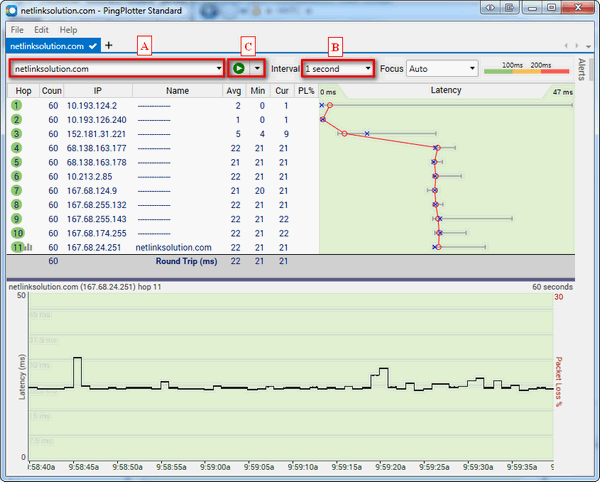PingPlotter, an application from Nessoft, LLC, is used to trace Internet connectivity issues. While this third-party utility is not developed by Thomson Reuters, support representatives may occasionally suggest that you use PingPlotter to pinpoint potential issues with your connection that may be affecting the performance of CS Professional Suite applications. PingPlotter tests the connection by sending data packets ("pings") to the target address and tracing the path they take across the Internet. If an Internet router along the path is dropping connectivity, it should show up in PingPlotter.
You may download the Standard or Professional versions of PingPlotter and try it free for 14 days from www.pingplotter.com.
Make sure you download or purchase the Standard or Pro version of PingPlotter and not the Freeware version. The Freeware version is not able to save your connection test history to a file.
Using PingPlotter to troubleshoot connectivity issues
PingPlotter is particularly helpful in troubleshooting Virtual Office CS and SaaS connectivity issues such as connection drops, slow data entry, and screen redraws.
- Download and install the Standard version of PingPlotter from www.pingplotter.com (it is not necessary to register or purchase this program during the free evaluation period).
- Launch PingPlotter
- Use the following settings (depicted in screenshot):
-
Enter netlinksolution.com or gofileroom.com in the Target Name field.
IMPORTANT! If the firm is in Farm D, follow the steps below:
- Go to http://ec2-reachability.amazonaws.com.
- Find the US-WEST column.
- Scroll down to the Oregon section.
- Select any IP address in the Oregon section.
- Give this IP address to the firm to run their PingPlotter trace to.
Additionally, note when this target is used, only the destination hop should show 100% packet loss as opposed to netlinksolution.com, which may show 100% packet loss on the final 3-6 hops in the route.
- Set Trace Interval to 1 second.
- Click the play icon button to begin testing.
-

Keep an instance of PingPlotter running in the background all day. If you experience a dropped session or slow performance, note the time of the occurrence. At the end of the day, save the sample set data to a file so that it can be reviewed later. When you send the data to your IT professional (or a support representative if requested), indicate what time the drops or slow performance occurred so that the occurrences can be correlated with the PingPlotter data.
Note: PingPlotter will very often show 100% packet loss on 3 to 6 hops before the netlinksolution.com destination. These are internal routers within our data center. As a security measure, the internal routers do not reply to PingPlotter, but will forward the packets on, so these hops can often be disregarded. If the end host (netlinksolution.com) replies, the connection worked even if there are a few hops near the end with packet loss.
Saving PingPlotter history to a file
- Choose File > Export Sample Set > All Data.
- Select a folder to save the .pp2 file. Once you have the file saved, send it to your qualified IT professional, your ISP, or the support representative (if we have requested the file).
Reviewing PingPlotter data for problems
When you review PingPlotter data, set your Samples to include to 1. This will show each ping individually rather than averaging the data together. Look for periods of sustained packet loss on the end host. Packet loss shows up as a red vertical bar along the graph on the bottom of the window.
A few seconds of packet loss may be sufficient to cause the Citrix client to drop connection. When you find sustained packet loss, double-click within the red bar at the bottom and find the last host that responds in the top section. If you frequently see this host as the last responder, it may be causing the connectivity problems. Often it is with a third-party Internet backbone router. These problems may be difficult to resolve, as neither Thomson Reuters nor you hold a business relationship with the company that controls the problem router.
Additionally, look for high latency (in this context, the delay for the ping to reach a specific hop, which is measured in milliseconds), which can also translate to disconnections and general performance issues as well. Latency for most high-speed Internet connections is typically under 100ms, with 40ms or less being ideal. Anything higher than a sustaining latency of over 100ms could be potentially cause performance issues, and points of latency reaching 200ms and higher (which will show in the PingPlotter graphs as yellow and red) will often have a significant impact.
If you do indeed see any packet loss or high latency, work with your qualified IT professional and ISP to determine the cause and resolution. If the issues are occurring outside of your ISP's network, they often have existing relationships with the other provider and can work with them to resolve the issue. In rare circumstances where your ISP is unable to work with a provider that manages a hop closer to our data center, Thomson Reuters' network technicians may be able to assist.
Additional Resources
PingPlotter offers resources for you and your qualified IT professional to use this utility and interpret these findings with walkthrough guides, information on common network problems, a support forum, and more. For more information, visit PingPlotter Support. ![]() (What's this?)
(What's this?)
Was this article helpful?
Thank you for the feedback!
Support: To provide PingPlotter logs to a consultant for review, use a CFR. If the consultant reviews the PingPlotter logs and determines that the issue lies with the internet backbone's router (the router used by the user's ISP) you can use the following Outlook template directing the user to contact their ISP: PingPlotter email template
If using this template, add the user's email, the router information provided to you by the consultant, and the User Services signature.



